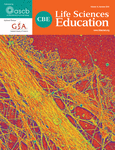Teaching Real Data Interpretation with Models (TRIM): Analysis of Student Dialogue in a Large-Enrollment Cell and Developmental Biology Course
Abstract
We present our design for a cell biology course to integrate content with scientific practices, specifically data interpretation and model-based reasoning. A 2-yr research project within this course allowed us to understand how students interpret authentic biological data in this setting. Through analysis of written work, we measured the extent to which students’ data interpretations were valid and/or generative. By analyzing small-group audio recordings during in-class activities, we demonstrated how students used instructor-provided models to build and refine data interpretations. Often, students used models to broaden the scope of data interpretations, tying conclusions to a biological significance. Coding analysis revealed several strategies and challenges that were common among students in this collaborative setting. Spontaneous argumentation was present in 82% of transcripts, suggesting that data interpretation using models may be a way to elicit this important disciplinary practice. Argumentation dialogue included frequent co-construction of claims backed by evidence from data. Other common strategies included collaborative decoding of data representations and noticing data patterns before making interpretive claims. Focusing on irrelevant data patterns was the most common challenge. Our findings provide evidence to support the feasibility of supporting students’ data-interpretation skills within a large lecture course.



